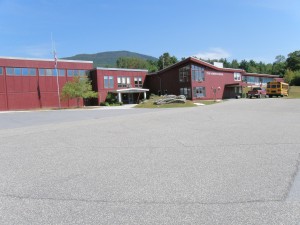By George Harvey
 The school board of the Dorset School, in Dorset, Vermont, began studying the possibility of powering the school with solar photovoltaics (PVs) in the spring of 2013. It was easy to see how the school could benefit from such a system. It was even easy to see a likely place to put the system. What was difficult was finding an organization that could provide a plan the school board was entirely comfortable with.
The school board of the Dorset School, in Dorset, Vermont, began studying the possibility of powering the school with solar photovoltaics (PVs) in the spring of 2013. It was easy to see how the school could benefit from such a system. It was even easy to see a likely place to put the system. What was difficult was finding an organization that could provide a plan the school board was entirely comfortable with.
The school provides education for kindergarten through eighth grade. Even so, there are people among its graduates who feel a sense of loyalty to it. One of those people is Thomas Hand, whose activities are discussed in two other articles in this issue of Green Energy Times. One of these is the article on Hand Motors, and the other is on Glow Heat.
When the Dorset School’s board felt stymied on the issue of PVs, Jim Hand, Thomas’ father, got together with his sons Thomas and Jamie and proposed that Hand and Sun, their energy company, help the school out. This led to the installation of a solar system, which is being installed as this article is being written.
The problem the school board had was that they felt they needed price stability for power purchases, but were unable to put down an initial investment out of their budget. Other financing options did not allow for the combination. Hand and Sun, however, gave them a deal that did not require a down payment, guaranteed the price of electricity at 90% of what they had been paying, and gave the school the option of buying the system at a fair market value after seven years. The school’s system is 114 kW, and should provide most of the electrical power the school needs. It is mounted on the school’s roof.
Jim Hand commented on this, saying, “We are not doing this to make money. We are doing it because the kids went to school there.”
“We are taking a chance,” Thomas Hand said. “If the market for electrical power goes the wrong way, we could suffer for it, but probably not much. It would have to go badly wrong for us to get burned.”
There are other energy projects the school might undertake. The heating system burns 15,000 gallons of oil each year, and one of its three boilers is getting to the point that it needs to be replaced. Thomas Hand has done a walkthrough to see what the costs and benefits of air-source heat pumps might be. Typically, heat pumps are as inexpensive to operate, in terms of heat delivered, as cordwood or wood pellets. They are also cleaner, in terms of emissions, if they are powered by renewable power, which in this case they can be.
He says his initial suggestion will probably be that the one old boiler should be used only as a backup for below zero weather, with day-to-day heating done by heat pumps. This would allow the school board to get comfortable with the equipment and how it operates, including the costs, before committing to installing more heat pumps to provide for most of the heating load. They would be able to project the budget based on real data taken in the school itself, and make their decision on future changes accordingly.
Each step of the way, the Dorset School is setting an example other schools could follow, reducing its energy use, its energy bill, and its carbon emissions.








Leave a Reply